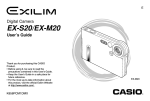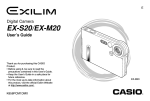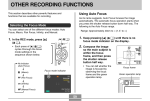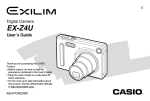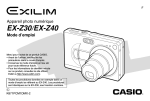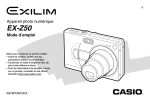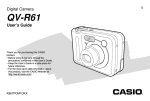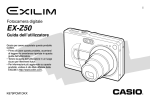Download EXS20_M20_2
Transcript
BASIC IMAGE RECORDING BASIC IMAGE RECORDING This section describes the basic procedure for recording an image. IMPORTANT! • Make sure your fingers or the strap does not block the flash or lens. Flash Recording an Image Lens Aiming the Camera Use both hands to hold the camera still when shooting an image. Holding the camera with one hand increases the chance of movement, which can blur your images. • Horizontal • Vertical Hold the camera still in both hands, with your arms firmly against your sides. NOTE • Your image will be blurred if you move the camera when pressing the shutter release button. Press the shutter release button carefully, taking care that there is no camera movement. This is especially important when available lighting is low, which slows down the shutter speed. When holding the camera vertically, make sure that the flash is above the lens. Hold the camera still with both hands. 43 BASIC IMAGE RECORDING 3. Compose the image Recording an lmage on the monitor screen. Your camera automatically adjusts shutter speed in accordance with the brightness of the subject. Images you record are stored in the camera’s built-in memory, or to a memory card if you have one loaded in the camera. • When an optionally available SD memory card or MultiMediaCard (MMC) is loaded in the camera, images are stored on the card (page 125). • You can compose images using either the monitor screen or the optical viewfinder. 4. Press the shutter to turn on the camera. 2. Align the mode selector with “ (REC). 03/12/24 12:58 • When using the optical viewfinder, you can turn off the monitor screen to save power (page 25). 1. Press the power button • This causes an image or a message to appear on the monitor screen. 12 1600 1200 NORMAL release button to record the image. ON/OFF Power button Mode selector Shutter release button ” • The number of images that can be stored in memory depends on the resolution setting you are using (pages 52, 183). • This enters the REC mode for image recording. • Depending on the distance or angle between the subject and the camera, the image you see in the viewfinder may not be exactly the image that is recorded. 44 BASIC IMAGE RECORDING About the REC Mode Monitor Screen Recording Precautions • The image shown on the monitor screen in the REC mode is a simplified image for composing purposes. The actual image is recorded in accordance with the image quality setting currently selected on your camera. The image saved in file memory has much better resolution and detail than the REC mode monitor screen image. • Certain levels of subject brightness can cause the response of the REC mode monitor screen to slow down, which causes some static noise in the monitor screen image. • Never open the battery cover or place the camera onto the USB cradle while the operation/flash charge lamp is flashing. Doing so not only causes the current image to be lost, it can also corrupt images already stored in file memory and even lead to malfunction of the camera. • Never remove the memory card while an image is being recorded to the memory card. • Fluorescent lighting actually flickers at a frequency that cannot be detected by the human eye. When using the camera indoors under such lighting, you may experience some brightness or color problems with recorded images. • When “Auto” is selected for the ISO sensitivity setting (page 72), the camera automatically adjusts its sensitivity in accordance with the brightness of the subject. This can cause some static noise to appear in images of relatively dark subjects. • When “Auto” is selected for the ISO sensitivity setting (page 72), the camera raises the sensitivity and uses a faster shutter speed. Because of this, you need to guard against camera movement if you have flash turned off (page 47) when recording a dimly lit subject. • If unwanted light is shining on the lens, shade the lens with your hand when recording the image. 45 BASIC IMAGE RECORDING 5. In the REC mode, use [] and [] to change Using Zoom the digital zoom factor. You can use the digital zoom feature of your camera to zoom in on the center of an image. Performing a zoom operation toggles the zoom factor between 1X and 4X. [] : Zoom in. [] : Zoom out. 1. In the REC mode, press [MENU]. 2. Use [] and [] to select the “REC” tab. 3. Use [] and [] to select “Digital Zoom”, and then press []. Zoom out 4. Use [] and [] to select “On”, and then 6. Record the image. press [SET]. • Selecting “Off” disables digital zoom. 46 Zoom in BASIC IMAGE RECORDING IMPORTANT! Using the Flash • Zoom is disabled whenever the monitor screen is turned off (page 25). • Using digital zoom can cause degradation of the recorded image. • To disable digital zoom, select “Off” for the “Digital Zoom” setting on the “REC” tab. Perform the following steps to select the flash mode you want to use. 1. In the REC mode, press [MENU]. 2. Use [] and [] to select the “REC” tab. NOTE 3. Use [] and [] to select “Flash”, and then • You can use the key customization feature (page 75) to configure the camera so the digital zoom factor changes whenever you press [] and [] while in the REC mode. press []. 4. Use [] and [] to select the flash mode you want, and then press [SET]. To do this: Select this setting: Have the flash fire automatically when required (Auto Flash) Auto Turn off the flash (Flash Off) Always fire the flash (Flash On) Fire a pre-flash followed by image recording with flash, reducing the chance of red-eye in the image (Redeye reduction). Have the flash fire automatically when required. 47 BASIC IMAGE RECORDING ■ About Red-eye Reduction 5. Record the image. Using the flash to record at night or in a dimly lit room can cause red spots inside the eyes of people who are in the image. This is caused when the light from the flash reflects off of the retina of the eye. Red-eye reduction fires a preflash, which causes the irises in the eyes of any people in the image to close. This is followed by another flash operation when the image is actually recorded. IMPORTANT! • The flash unit of this camera fires a number of times when you record an image. The initial flashes are pre-flashes, which the camera uses to obtain information it uses for exposure settings. The final flash is for recording. Make sure that you keep the camera still until the shutter releases. • Image recording may not be performed if you press the shutter release button while the operation/flash charge lamp is flashing amber. IMPORTANT! Note the following important points when using redeye reduction. • Red-eye reduction does not work unless the people in the image are looking directly at the camera (flash). Before pressing the shutter release button, call out to the subjects so they all look at the camera. • Red-eye reduction may not work very well if the subjects are located far away from the camera. NOTE • You can use the key customization feature (pages 74, 75) to configure the camera so the flash mode changes whenever you press [] and [], or [] and [] while in the REC mode. 48 BASIC IMAGE RECORDING • The flash unit may not be able to charge when battery on power is low. Low battery power is indicated by the the monitor screen, and when the flash fails to fire properly resulting in poor image exposure. When these symptoms occur, charge the camera’s battery as soon as possible. • When the red-eye reduction mode ( ) is selected, flash intensity is adjusted automatically in accordance with the exposure. The flash may not fire at all when the subject is brightly lit. • Using flash in combination with another light source (daylight, fluorescent light, etc.) can result in abnormal image colors. Flash Precautions Take care that your fingers do not block the flash when you hold the camera. Covering the flash with your finger can greatly reduce its effectiveness. Flash • The approximate effective range of the flash is shown below. The flash is unable to adequately illuminate a subject that is outside this range. 0.8 meter to 1.5 meters (2.6´ to 4.9´) (ISO Sensitivity : “Auto”) • The flash takes anywhere from a few seconds as long as 10 seconds to attain full charge after being fired. The actual time required depends on the battery level, temperature, and other conditions. • The flash does not fire during movie recording. This is indicated by on the monitor screen. 49 BASIC IMAGE RECORDING IMPORTANT! Recording Macro Images • Selecting the macro mode causes the to appear on the monitor screen. • Normally, you should leave the Normal ( ( ) selector setting at “ ”. You can select either normal or macro (close-up) recording using the selector located on the left side of the camera. The table below describes the two settings available with the selector. To do this: Select this setting: Shoot normal images, at a distance of about 1m (39.4˝) to infinity (Normal) Shoot close-ups, at a distance of about 30cm (11.8˝) (Macro) • The distances indicated above represent the distance from the camera’s lens surface to the subject. 1. Align the Normal ( )/ Macro ( ) selector with “ ”. Normal ( selector )/Macro ( ) MENU 2. Record the image. 50 indicator )/Macro BASIC IMAGE RECORDING To do this: Using the Self-timer The self-timer lets you select either a 2-second or 10second delay of the shutter release after you press the shutter release button. A Triple Self-timer feature lets you perform three consecutive self-timer operations to record three images. Select this setting: Specify a 10-second self-timer 10 sec Specify a 2-second self-timer 2 sec Specify Triple Self-timer X3 Disable the self-timer Off • With the Triple Self-timer, the camera records a series of three images in the sequence described below. 1. In the REC mode, press [MENU]. 2. Use [] and [] to select the “REC” tab. 1. The camera performs a 10-second countdown and then records the first image. 3. Use [] and [] to select “Self-timer”, and 2. The camera prepares to record the next image. The amount of time required for preparation depends on the camera’s current “Size” and “Quality” settings, the type of memory (built-in or card) you are using for image storage, and whether or not the flash is charging. then press []. 4. Use [] and [] to select the self-timer time you want to use, and then press [SET]. • Selecting “Off” in step 4 disables the self-timer. 3. After preparation is complete, the indicator “1sec” appears on the monitor screen, and another image is recorded one second later. 4. Steps 2 and 3 are repeated once more to record the third image. 51 BASIC IMAGE RECORDING 5. Record the image. • When you press the shutter release button, the self-timer lamp flashes and the shutter releases after the selftimer reaches the end of its countdown. Specifying Image Size and Quality You can specify the image size and image quality to suit the type of image you are recording. To specify the image size Self-timer lamp 1. In the REC mode, press [MENU]. • You can interrupt an ongoing self-timer countdown by pressing the shutter release button while the selftimer lamp is flashing. 2. Use [] and [] to select the “REC” tab. 3. Use [] and [] to select “Size”, and then press []. 4. Use [] and [] to select the setting you NOTES want, and then press [SET]. • The “2 sec” self-timer setting is best when shooting with a slow shutter speed, because it helps to avoid blurring of images due to hand movement. • You can use the key customization feature (page 75) to configure the camera so the self-timer setting changes whenever you press [] and [] while in the REC mode. 1600 x 1200 : 1600 x 1200 pixels 1600 x 1072 (3:2) : 1600 x 1072 pixels 52 1280 x 960 : 1280 x 960 pixels 640 x 480 : 640 x 480 pixels BASIC IMAGE RECORDING NOTES To specify image quality • If you plan to make large prints of your images or otherwise use them in applications where highresolution is your top priority, select the “1600 x 1200” image size. • If you plan to send images as e-mail attachments or otherwise use them in applications where data economy is your top priority, select the “640 x 480” image size. • Selecting the “1600 x 1072 (3:2)” image size records images with a 3:2 (vertical : horizontal) aspect ratio, which is optimal for printing on paper with an aspect ratio of 3:2. 1. In the REC mode, press [MENU]. 2. Use [] and [] to select the “REC” tab. 3. Use [] and [] to select “Quality”, and then press []. 4. Use [] and [] to select the setting you want, and then press [SET]. 53 To get this: Select this setting: Very high quality, but large file size Fine Normal quality Normal Small file size, but low quality Economy BASIC IMAGE RECORDING NOTE • Use the “Fine” setting when image quality is your top priority and file size is secondary. Conversely, use the “Economy” setting when file size is your top priority and image quality is secondary. IMPORTANT! • Actual file size depends on the type of image you record. This means that the remaining image capacity noted on the monitor screen may not be exactly accurate (pages 23, 183). 54 OTHER RECORDING FUNCTIONS OTHER RECORDING FUNCTIONS 3. Use [왖] and [왔] to This chapter describes the other powerful features and functions that are available for recording. change the exposure compensation value, and then press [SET]. Exposure Compensation (EV Shift) • Pressing [SET] registers the displayed value. Exposure compensation lets you change the exposure setting (EV value) manually to adjust for the lighting of your subject. This feature helps to achieve better results when recording a backlit subject, a strongly lit subject indoors, or a subject that is against a dark background. EV value [왖] : Increases the EV value. A higher EV value is best used for light-colored subjects and backlight subjects. EV Shift Range: –2.0EV to +2.0EV Steps: 1/3EV 1. In the REC mode, press [MENU]. 2. Select the “REC” tab, select “EV Shift”, and then press [왘]. [왔] : Decreases the EV value. A lower EV value is best for dark-color subjects and for shooting outdoors on a clear day. Exposure compensation value 55 OTHER RECORDING FUNCTIONS • To cancel EV Shift, adjust the value until it becomes 0.0. Adjusting White Balance The wavelengths of the light produced by various light sources (sunlight, light bulb, etc.) can affect the color of a subject when it is recorded. White balance lets you make adjustments to compensate for different lighting types, so the colors of an image appear more natural. 4. Record the image. IMPORTANT! • When shooting under very dark or very bright conditions, you may not be able to obtain satisfactory results even after performing exposure compensation. 1. In the REC mode, press [MENU]. 2. Select the “REC” tab, select “White Balance”, and then press [왘]. NOTES • Performing an EV shift operation causes the metering mode to switch automatically to center weighted metering. Returning the EV shift value to 0.0 causes the metering mode to change back to multi-pattern metering. • You can use key customization (page 74) to configure the camera to perform exposure compensation whenever you press [왗] and [왘] while in the REC mode. 56 OTHER RECORDING FUNCTIONS 3. Use [왖] and [왔] to select the setting you Adjusting White Balance Manually want, and then press [SET]. When shooting under these conditions: Normal conditions Under some light sources, automatic white balance under the “Auto” setting can take a long time to complete. Also, the auto white balance range (color temperature range) is limited. Manual white balance helps to ensure that colors are recorded correctly for a particular light source. Note that you must perform manual white balance under the same conditions you will be shooting under. You must also have a white piece of paper or other similar object on hand in order to perform manual white balance. Select this setting: Auto Outdoor daylight Shade Incandescent light bulb (reddish tinge) Fluorescent light (greenish tinge) Difficult lighting that requires manual control (See “Adjusting White Balance Manually”.) 1. In the REC mode, press [MENU]. Manual 2. Select the “REC” tab, select “White Balance”, and then press [왘]. NOTES • Selecting “Manual” changes white balance to the settings achieved the last time a manual white balance operation was performed. • You can use the key customization feature (pages 74, 75) to configure the camera so the white balance setting changes whenever you press [왗] and [왘], or [왖] and [왔] while in the REC mode. 3. Use [왖] and [왔] to select “Manual”. • This causes the object you last used to adjust manual white balance to appear on the monitor screen. 57 OTHER RECORDING FUNCTIONS 4. Point the camera at a white piece of paper or Using the BESTSHOT Mode similar object under the lighting conditions for which you want to set the white balance, and then press the shutter release button. Selecting one of the 15 BESTSHOT scenes automatically sets up the camera for recording a similar type of image. ■ Example Sample Scene • Portrait • Scenery • Night Scene • Night Scene Portrait A white piece of paper • This starts the white balance adjustment procedure. The message “Complete” appears on the monitor screen after white balance adjustment is complete. • Dim lighting or pointing the camera at a dark colored object while performing manual white balance adjustment can cause the procedure to take a long time to complete. 5. Press [SET]. • This registers the white balance settings and returns to the REC mode. 58 OTHER RECORDING FUNCTIONS 1. In the REC mode, press [MENU]. IMPORTANT! • Sample scene number 4 is Coupling Shot scene (page 62). Sample scene number 5 is a Pre-shot scene (page 64). • BESTSHOT scenes were not recorded using this camera. They are provided as samples only. • Images recorded using a BESTSHOT scene may not produce the results you expected due to shooting conditions and other factors. • After selecting a BESTSHOT scene, you can change to a different one by using [왗] and [왘] to scroll through available scenes. When the one you want is displayed, press [SET]. 2. Select the “REC” tab, select “REC Mode”, and then press [왘]. 3. Use [왖] and [왔] to select “ BESTSHOT”, and then press [SET]. • This enters the BESTSHOT mode and displays a sample scene. 4. Use [왗] and [왘] to select the sample scene NOTE you want, and then press [SET]. • You can use the key customization feature (page 74) to configure the camera to enter the BESTSHOT mode whenever you press [왗] or [왘] while in the REC mode. Operation guidance and the currently selected BESTSHOT scene appear on the display for about two seconds after you enter the BESTSHOT mode this way, or if the camera is in the BESTSHOT mode when you turn it on. 5. Record the image. 59 OTHER RECORDING FUNCTIONS 6. Use [왗] and [왘] to Creating Your Own BESTSHOT Setup display the image whose setup you want to register as a BESTSHOT scene. You can use the procedure below to save the setup of an image you recorded for later recall when you need it again. Recalling a setup you save automatically sets up the camera accordingly. 1. In the REC mode, press [MENU]. 7. Use [왖] and [왔] to 2. Select the “REC” tab, select “REC Mode”, and select “Save”, and then press [SET]. then press [왘]. 3. Use [왖] and [왔] to select “ • This registers the setup. BESTSHOT”, • Now you can use the procedure on page 59 to select your user setup for recording. and then press [SET]. • This enters the BESTSHOT mode and displays a sample scene. 4. Use [왗] and [왘] to display “Register User Scene”. 5. Press [SET]. 60 OTHER RECORDING FUNCTIONS ■ To delete a BESTSHOT user setup IMPORTANT! • BESTSHOT user setups are located in the camera’s built-in memory after the built-in sample scenes. • Note that formatting the built-in memory (page 123) deletes all BESTSHOT user setups. 1. In the REC mode, press [MENU]. 2. Select the “REC” tab, select “REC Mode”, and then press [왘]. 3. Use [왖] and [왔] to select “ NOTES BESTSHOT”, and then press [SET]. • The following are the settings that are included in a BESTSHOT user setup: EV shift value, white balance mode, flash mode, and ISO sensitivity. • Note that images recorded with this camera only can be used to create a BESTSHOT user setup. • You can have up to 999 BESTSHOT user setups in the camera’s built-in memory at one time. • You can check the current setup of a scene by displaying the various setting menus. • When you register a BESTSHOT user setup, it is automatically assigned a file name using one of the formats shown below, depending on your camera model. • This enters the BESTSHOT mode and displays a sample scene. 4. Use [왗] and [왘] to display the user setup you want to delete. 5. Press [왔] ( ) to delete the user setup. • You can also delete a user setup by using your computer to delete its file in the “SCENE” folder in the camera’s built-in memory (page 142). EX-S20 : UES20nnn.JPE (n = 0 to 9) EX-M20 : UEM20nnn.JPE (n = 0 to 9) 61 OTHER RECORDING FUNCTIONS Combining Shots of Two People into a Single Image (Coupling Shot) • Combined Images The Coupling Shot mode lets you record images of two people and combine them into a single image. This makes it possible for you to include yourself in group images, even when there is no one else around to record the image for you. Coupling Shot is available in the BESTSHOT mode (page 58). • First Image This is the part of the image that does not include the person who is recording the first image. 1. In the REC mode, press [MENU]. 2. Select the “REC” tab, select “REC Mode”, and then press [왘]. 3. Use [왖] and [왔] to select “ BESTSHOT”, and then press [SET]. • Second Image 4. Use [왗] and [왘] to select “Coupling Shot”, Making sure that the background of the image is aligned correctly, record the image of the person who recorded the first image. and then press [SET]. 62 OTHER RECORDING FUNCTIONS 5. Use the monitor 6. Next, use the monitor screen to compose and record the left side of the image. screen to compose the right side of the image, taking care to align the actual background with the semi-transparent image of the background of the left-side image, which remains on the monitor screen. When everything is aligned correctly, record the image. • The exposure, white balance, zoom, and flash settings are fixed for this type of image. Semi-transparent image • Pressing [MENU] any time after step 5 of the above procedure cancels the first image and returns to step 5. 63 OTHER RECORDING FUNCTIONS • Freeze the background on the monitor screen. Recording a Subject onto an Existing Background Image (Pre-shot) Pre-shot helps you get the background you want, even if you need to ask someone else to record the image for you. Basically, Pre-shot is a two-step process. 1. You compose the background you want and press the shutter release button, which causes a semi-transparent image of the background to remain on the monitor screen. 2. Ask someone else to record a shot of you against your original background, telling them to compose the image by using the semi-transparent monitor screen image as a guide. • The camera stores the image produced by step 2 only. • Depending on how the image is actually composed in step 2, its background may not be exactly the same as the one you composed in step 1. • Record the image, using the background on the monitor screen as a guide. Note that Pre-shot is available in the BESTSHOT mode only (page 58). • This records the image. 64 OTHER RECORDING FUNCTIONS 1. In the REC mode, press [MENU]. 6. Next, use the monitor screen to compose the subject with the semi-transparent background shown on the monitor screen. When everything is aligned correctly, record the image. 2. Select the “REC” tab, select “REC Mode”, and then press [왘]. 3. Use [왖] and [왔] to select “ BESTSHOT”, and then press [SET]. 4. Use [왗] and [왘] to select “Pre-shot”, and then press [SET]. Semi-transparent image • This records the image composed on the monitor screen in step 6. The reference background image is not recorded. • Pressing [MENU] any time after step 5 of the above procedure cancels the background image and returns to step 5. 5. Freeze the background on the monitor screen. • Though a semi-transparent image of the background appears on the monitor screen in step 6, the background image is not saved in memory at this time. • The exposure, white balance, zoom, and flash settings are fixed for this type of image. 65 OTHER RECORDING FUNCTIONS 3. Use [왖] and [왔] to Using the Movie Mode Remaining capacity select “ Movie”, and then press [SET]. You can record movies up to 60 seconds long. The EXM20 even lets you record audio along with your movies. • “Remaining capacity” shows how many 60second movies can still be recorded to memory. • File Format: AVI AVI format conforms to the Motion JPEG format promoted by the Open DML Group. • Image Size: 320 x 240 pixels Remaining recording time • Movie File Size: Approximately 160KB/second. 4. Point the camera at • Maximum Movie Length — One Movie: 60 seconds — Total Movie Time: 60 seconds with built-in memory; 380 seconds with 64MB SD memory card Movie recording indicator the subject and then press the shutter release button. • Movie recording continues for 60 seconds, or until you stop it by pressing the shutter release button again. 1. In the REC mode, press [MENU]. 2. Select the “REC” tab, select “REC Mode”, and then press [왘]. • The remaining recording time value counts down on the monitor screen as you record. • When movie recording is complete, the movie file is stored in file memory. • To cancel storage of the movie file, use [왔] to select “Delete” while file storage is being performed, and then press [SET]. 66 OTHER RECORDING FUNCTIONS IMPORTANT! Recording Audio (EX-M20 Only) • The flash does not fire in the Movie mode. • The EX-M20 also records audio. Note the following points when recording a movie. — Take care that you do not block the microphone with your fingers. Adding Audio to a Snapshot You can add audio to a snapshot after you record it. • Image Format: JPEG JPEG is an image format that provides efficient data compression. The file extension of a JPEG file is “.JPG”. • Audio Format: WAVE/ADPCM recording format This is the Windows standard format for audio recording. The file extension of a WAVE/ADPCM file is “.WAV”. Microphone — Good recording results are not possible when the camera is too far from the subject. — Operating camera buttons during recording can cause button noise to be included in the audio. — Movie audio is recorded in monaural. • Recording Time: Up to about 30 seconds per image • Audio File Size: Approximately 240KB (30-second recording of approximately 8KB per second) 67 OTHER RECORDING FUNCTIONS 1. In the REC mode, press [MENU]. 5. Press the shutter release button to start audio recording. 2. Select the “REC” tab, select “REC Mode”, and • The operation/flash charge lamp flashes green as recording is performed. then press [왘]. 3. Use [왖] and [왔] to select “ ( + • Even if you have the monitor screen turned off (page 25), the monitor screen turns on while you are adding audio to a snapshot. )”, and then press [SET]. • This enters the Snapshot Audio Mode. 6. Recording stops after about 30 seconds or 4. Press the shutter when you press the shutter release button. release button to record the image. • After the image is recorded, the camera enters audio recording standby, with the image you just recorded on the monitor screen. Remaining recording time • You can cancel audio recording standby by pressing [MENU]. 68 OTHER RECORDING FUNCTIONS 4. Press the shutter release button to start voice Recording Your Voice recording. The Voice Recording Mode provides quick and easy recording of your voice. • The remaining recording time value counts down on the monitor screen and the operation/flash charge lamp flashes green as recording is performed. • Audio Format: WAVE/ADPCM recording format This is the Windows standard format for audio recording. The file extension of a WAVE/ADPCM file is “.WAV”. • Pressing the [DISP] button during voice recording turns off the monitor screen. The monitor screen turns back on automatically when recording is complete. • Recording Time: Approximately 40 minutes with built-in memory • You can insert index marks while recording by pressing [SET]. See page 96 for information about jumping to an index mark during playback. • Audio File Size: Approximately 240KB (30-second recording of approximately 8KB per second) 5. Recording stops when you press the shutter 1. In the REC mode, press [MENU]. release button, when memory becomes full, or when the battery goes dead. 2. Select the “REC” tab, select “REC Mode”, and then press [왘]. 3. Use [왖] and [왔] to select “ Voice”, and then press [SET]. • This enters the Voice Recording Mode. Remaining recording time 69 OTHER RECORDING FUNCTIONS ■ Audio Recording Precautions Using the Histogram • Keep the microphone on the front of the camera pointed at the subject. • Take care that you do not block the microphone with your fingers. You can use the [DISP] button to display a histogram on the monitor screen. The histogram lets you check exposure conditions as you record images (page 25). You can also display the histogram of a recorded image in the PLAY mode. Microphone • Good recording results are not possible when the camera is too far from the subject. • Operating camera buttons during recording can cause button noise to be included in the audio. • Pressing the power button or changing the mode selector setting stops recording at that point and stores any audio recorded up to that point. • You can also perform “after-recording” to add audio to a snapshot after recording it, and also change the audio recorded for an image. See page 93 for more information. Histogram A histogram is a graph that represents the lightness of an image in terms of the number of pixels. The vertical axis indicates the number of pixels, while the horizontal axis indicates lightness. You can use the histogram to determine whether an image includes the shadowing (left side), mid tones (center), and highlighting (right) required to bring out sufficient image detail. If the histogram appears too lopsided for some reason, you can use EV shift (exposure compensation) to move it left or right in order to achieve better balance. Optimum exposure can be achieved by correcting exposure so the graph is as close to the center as possible. 70 OTHER RECORDING FUNCTIONS • When the histogram is too far to the left, it means that there are too many dark pixels. This type of histogram results when the overall image is dark. A histogram that is too far to the left may result in “black out” of the dark areas of an image. IMPORTANT! • Note that the above histograms are shown for illustrative purposes only. You may not be able to achieve exactly the same shapes for particular subjects. • A centered histogram does not necessarily guarantee optimum exposure. The recorded image may be over-exposed or under-exposed, even though its histogram is centered. • You may not be able to achieve an optimum histogram configuration due to the limitations of EV shift. • Use of the flash as well as certain shooting conditions can cause the histogram to indicate exposure that is different from the actual exposure of the image when it was recorded. • This histogram does not appear when you are using Coupling Shot (page 62). • When the histogram is too far to the right, it means that there are too many light pixels. This type of histogram results when the overall image is light. A histogram that is too far to the right may result in “white out” of the light areas of an image. • A centered histogram indicates that there is good distribution of light pixels and dark pixels. This type of histogram results when the overall image is at optimal lightness. 71 OTHER RECORDING FUNCTIONS IMPORTANT! REC Mode Camera Settings • Increasing ISO sensitivity can cause static to appear inside an image. Select the ISO sensitivity setting that suits your shooting needs. • Using a high ISO sensitivity setting along with the flash to shoot a nearby subject may result in improper illumination of the subject. Specifying ISO Sensitivity Use the following procedure to select the ISO sensitivity setting that suits the type of image you are recording. 1. In the REC mode, press [MENU]. NOTE 2. Select the “REC” tab, select “ISO”, and then • You can use the key customization feature (page 74) to configure the camera so the ISO sensitivity setting changes whenever you press [왗] and [왘] while in the REC mode. press [왘]. 3. Use [왖] and [왔] to select the setting you want and then press [SET]. To get this: Select this setting: Automatic sensitivity selection Auto Conforms to ISO 64 ISO 64 Conforms to ISO 125 ISO 125 Conforms to ISO 250 ISO 250 Conforms to ISO 500 ISO 500 72 OTHER RECORDING FUNCTIONS Turning the On-screen Grid On and Off Turning Image Review On and Off You can display gridlines on the monitor screen to help you compose images and ensure that the camera is straight when recording. Image review displays an image on the monitor screen as soon as you record it. Use the following procedure to turn image review on and off. 1. In the REC mode, press [MENU]. 2. Select the “REC” tab, select “Review”, and then press [왘]. 3. Use [왖] and [왔] to select the setting you want, and then press [SET]. 1. In the REC mode, press [MENU]. To do this: Select this setting: 2. Select the “REC” tab, select “Grid”, and then Display images on the monitor screen for about one second immediately after they are recorded On Do not display images immediately after they are recorded Off press [왘]. 3. Use [왖] and [왔] to select the setting you want, and then press [SET]. To do this: Select this setting: Display the grid On Hide the grid Off 73 OTHER RECORDING FUNCTIONS Assigning Functions to the [왗] and [왘] Keys When you want to assign this function to [왗] and [왘] keys: Select this: A “key customization” feature lets you configure the [왗] and [왘] keys so they change camera settings whenever they are pressed in the REC mode. After you configure the [왗] and [왘] keys, you can change the setting assigned to them without going through the menu screen. Recording mode • [왗] and [왘] cycle through recording modes. • EX-S20: Snapshot, BESTSHOT, Movie • EX-M20: Snapshot, BESTSHOT, Movie, Snapshot Audio, Voice Recording (page 173) REC Mode 1. In the REC mode, press [MENU]. Flash mode • [왗] and [왘] cycle through the flash mode settings (page 47). Flash EV shift • [왗] decreases compensation, [왘] increases compensation (page 55). EV Shift White balance setting • [왗] and [왘] cycle through white balance settings (page 56). White Balance ISO sensitivity • [왗] and [왘] cycle through ISO sensitivity settings (page 72). ISO No function assigned Off 2. Select the “REC” tab, select “L/R Key”, and then press [왘]. 3. Use [왖] and [왔] to select the setting you want, and then press [SET]. NOTE • The initial default setting is “REC Mode”. 74 OTHER RECORDING FUNCTIONS Assigning Functions to the [왖] and [왔] Keys A “key customization” feature lets you configure the [왖] and [왔] keys so they change camera settings whenever they are pressed in the REC mode. After you configure the [왖] and [왔] keys, you can change the setting assigned to them without going through the menu screen. 1. In the REC mode, press [MENU]. 2. Select the “REC” tab, select “U/D Key”, and then press [왘]. 3. Use [왖] and [왔] to select the setting you want, and then press [SET]. When you want to assign this function to [왖] and [왔] keys: Select this: Recording mode • [왖] and [왔] cycle through recording modes. • EX-S20: Snapshot, BESTSHOT, Movie • EX-M20: Snapshot, BESTSHOT, Movie, Snapshot Audio, Voice Recording (page 173) REC Mode Digital Zoom • [왖] increases the digital zoom factor, [왔] decreases the digital zoom factor (page 46). Digital Zoom Flash mode • [왖] and [왔] cycle through the flash mode settings (page 47). Flash White balance setting • [왖] and [왔] cycle through white balance settings (page 56). White Balance Self-timer mode • [왖] and [왔] cycle through self-timer modes (page 51). Self-timer No function assigned Off NOTE • The initial default setting is “Digital Zoom”. 75 OTHER RECORDING FUNCTIONS Specifying Power On Default Settings 1. In the REC mode, press [MENU]. The camera’s “mode memory” feature lets you specify the power on default settings individually for the REC mode, flash mode, white balance mode, ISO sensitivity, and digital zoom mode. Turning on mode memory for a mode tells the camera to remember the status of that mode when you turn off the camera, and restore it the next time you turn the camera back on. When mode memory is turned off, the camera automatically restores the initial factory default setting for the applicable mode. The following table shows what happens when you turn mode memory on or off for each mode. 2. Select the “Memory” tab, select the item you Function On REC Mode Flash White Balance ISO Digital Zoom want to change, and then press [왘]. 3. Use [왖] and [왔] to select the setting you want, and then press [SET]. Select this setting: Turn on mode memory so settings are restored at power on On Turn off mode memory so settings are initialized at power on Off Off IMPORTANT! Snapshot Setting when camera is turned off To do this: Auto • Note that BESTSHOT mode settings take priority over mode memory settings. If you turn the camera off while in the BESTSHOT mode, the camera’s Flash, White Balance, and ISO Sensitivity will be configured according to the BESTSHOT sample scene when you turn it back on again, regardless of mode memory on/off setting. • If you turn the camera off while in the Movie mode, the flash will be turned off when you turn the camera back on again, regardless of mode memory on/off setting. Auto Auto On 76 OTHER RECORDING FUNCTIONS Resetting the Camera Use the following procedure to reset all of the camera’s settings to their initial defaults as shown under “Menu Reference” on page 173. 1. In the REC mode or the PLAY mode, press [MENU]. 2. Select the “Set Up” tab, select “Reset”, and then press [왘]. 3. Use [왖] and [왔] to select “Reset”, and then press [SET]. • To cancel the procedure without resetting, select “Cancel” and press [SET]. 77



































